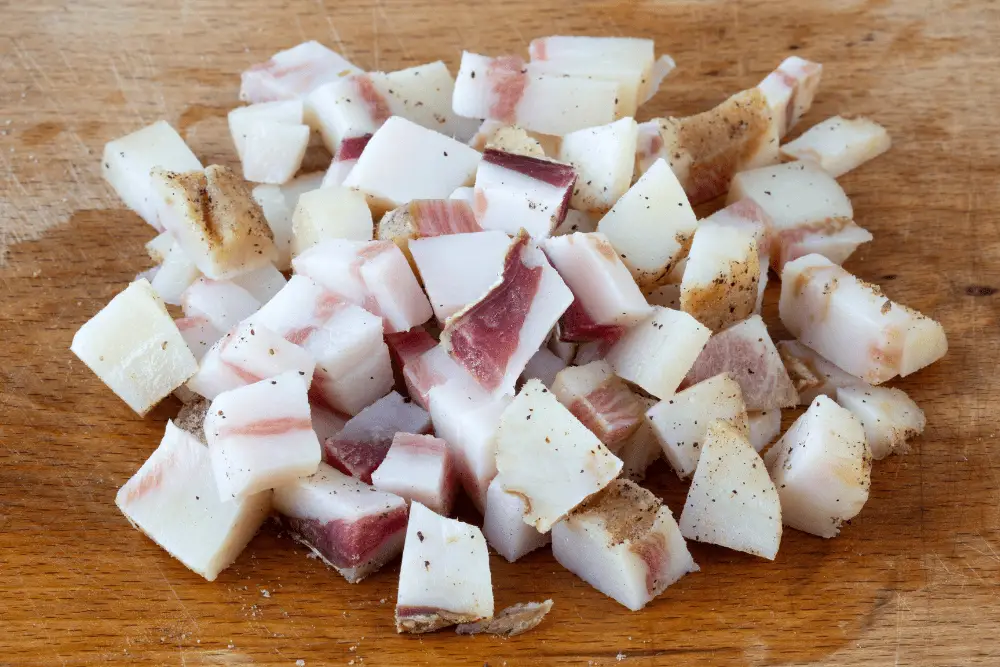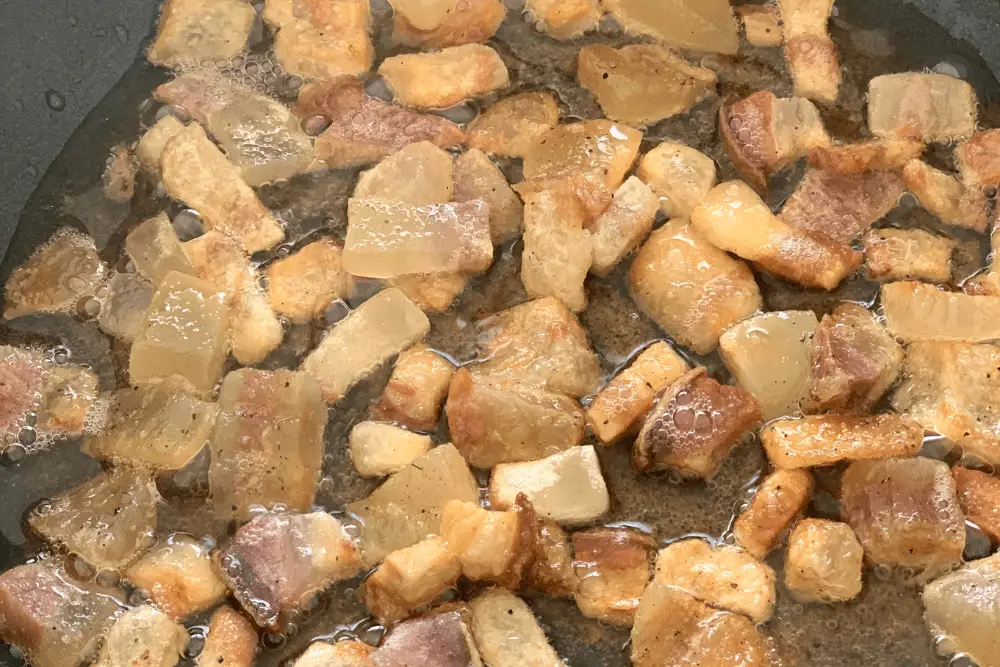Guanciale is a traditional Italian cured meat product made from pork jowls or cheeks cured in salt, sugar, and spices which usually include ground black or red pepper, thyme or fennel and sometimes even garlic.It is a specialty of central Italy, particularly Umbria and Lazio.
It has a strong, salty flavor and a chewy texture and is often used as a flavoring or seasoning ingredient in many Italian dishes.
For example, in Italy, celebrated pasta dishes such as Spaghetti alla carbonara, Bucatini all’Amatriciana and Pasta alla Gricia are typically made with guanciale. This is because when it is cooked, it releases a rich, fatty flavor that adds depth and complexity to these dishes.
Warning: When guanciale is not available, sometimes chefs substitute pancetta (or even back bacon) but the flavors are NOT the same. A true Italian can taste the difference and will be very displeased to say the least!
Introduction: what is guanciale?
Guanciale is a very flavorful cured meat product made from pork jowls or cheeks. The name is derived from guancia which is the Italian word for cheek. Overall it is a strong umami bomb that is salty with rich and concentrated pork flavor!
If you like pancetta, you will LOVE guanciale!
The cheek or jowl is cured using salt, pepper and spices. It has a high fat to meat ratio which is what gives it an intense sweet or savory pork flavor in combination with a light and melting texture. This leaves the melting mouthfeel that foodies love!
Traditionally it is salt-cured and then air-dried for two to four months. The curing process allows the flavors of the cure to penetrate the meat deeply, resulting in a stronger flavor.
So, if you like pork, you will LOVE guanciale. But if you don’t like pork, you will hate it even more because this process makes the pork flavors even stronger.
Different manufacturers will use different spicing mixtures and that can result in very different flavors in the meat.

History of guanciale
Guanciale has been a traditional ingredient in Italian cuisine for centuries, and is an important part of dishes like spaghetti alla carbonara and amatriciana.
Historically it was very difficult to find guanciale outside of Rome or the Lazio region in Italy. It has only been in the last decade or so that it became possible to find it more commonly in the United States.
Its newfound availability has made it much more popular, especially in the United States. Famous chefs like Jacob Kenedy have helped to popularize it.
How to make guanciale
To make guanciale, the pork jowl is trimmed of fat and skin and rubbed with a mixture of salt, sugar, black pepper, and sometimes red pepper flakes. Some will include garlic as well.
The jowl is then placed in a curing chamber where it will cure for 3-10 weeks. During this process, it will typically lose 30% or more of its original weight as the seasoning penetrates and flavors the meet.
During the curing process it looks like this:
Once it is dry, it can be sliced and eaten as is, or used in a variety of ways to enhance your meal.
Tips for using guanciale in your cooking
Because it is so intense in flavor, it is best to use a little guanciale either as a snack or as a flavoring.
- Appetizer: You can fry it for a crispy appetizer (see picture below)
- Mini-Sandwich: My favorite is to have it as part of small sandwich appetizer. Just add a small slice onto a small crostini from your antipasti try.
- Traditional Italian Dish: If you want an authentic carbonara or amatriciana, make sure it is authentic and has guanciale and not bacon.
- Flavoring: Use a little bit as a fat when cooking any protein in a skillet. It will add depth of flavor to your beef, chicken or even fish.
- Soups or stews: It will add a richness and depth of flavor to the vegetables in your soup.

How Do you cook it?
A low and slow approach is typically best – means cook it over low heat for a longer period of time so the fat will gradually render out.
Then if you are making vegetables, you can add them to the pan and continue sauteing greens that way. Or you can remove the guanciale and add it to your cooked pasta right before serving it.
How to make ITALIAN GUANCIALE at home – DRY AGING Authentically & Easy
In this video, Piero shares all his knowledge to create this amazing piece of charcuterie. He shows you step by step how to make this yourselves at home. This is authentic Italian Guanciale using all natural ingredients.
Learn all Italian Food terms in our Italian Food glossary
Guanciale Summary
In conclusion, guanciale is a delicious, traditional Italian ingredient that can be used in many different dishes. If you like strong pork flavors in your dishes, be sure to give guanciale a try!
Guanciale Frequently Asked Questions (FAQs)
How is guanciale different from pancetta?
Pancetta is probably the closest thing to guanciale among the Italian deli meats. But guanciale has a richer flavor and softer texture.
How is guanciale different from bacon?
Guanciale is made of pork cheek, whereas bacon is made of pork belly. Bacon is smoke and cured so it has a smokier flavor. Guanciale tens to be fattier with a more robust pork flavor because it is cured for longer periods of time. Also it has a slightly sweet flavor due the curing process.
What are substitutes for guanciale?
You can always use either pancetta or bacon. Pancetta lacks the subtly of the delicate spices found in guanciale though. And bacon will impact a much smokier flavor.
My name is Jay and I started this website to share my love of Deli Food. I am Jewish with Italian ancestry and grandparents who emigrated to the US from Poland, Russia and Turkey. This website is my celebration of the delicious flavors of international deli culture. Please feel free to send me your suggestions and feedback through the contact form.

